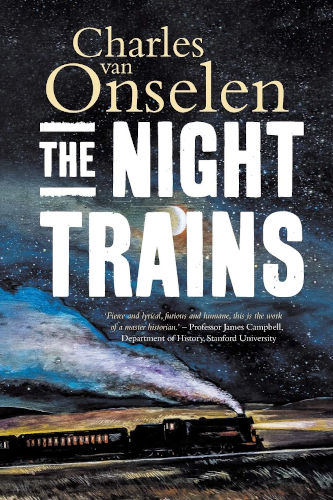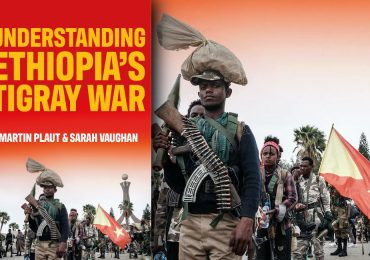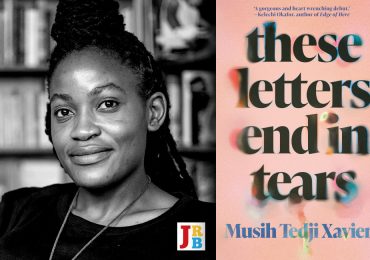Richard Poplak reviews The Night Trains by Charles van Onselen, a book grounded in the hard work of scouring the colonial archives before they sink permanently into oblivion.

The Night Trains: Moving Mozambican Miners to and from the Witwatersrand Mines, 1902–1955
Charles van Onselen
Jonathan Ball Publishers, 2019
Imagine a midnight train that runs from nothing to nowhere, a Hogwarts Express carrying not shoelace wizards but forced labourers, studiously unnoticed by the Muggles as it whisks by in the dark. Imagine that the railway, built to ferry coal from eastern Transvaal collieries to the nascent port of Lourenço Marques (now Maputo), also transports five million men between the years 1905 and 1960. And imagine that the Eastern Main Line, as it was named, has been all but forgotten, its archives left to moulder in flooded basements, its stories elided from two liberation histories in two failing postcolonial nation-states.
Traces, however, remain. The ghosts of dead passengers flit through the lyrics of the great gospel, ‘Shosholoza’, and they howl their way through Hugh Masekela’s ‘Stimela’:
They always cuss, and they curse the coal train,The coal train that brought them to Johannesburg. Whooo whooo!
Thanks to author and social historian Charles van Onselen, we can now supplement this record with an important (if incomplete) new text: The Night Trains. Van Onselen remains one of the best popular historians this country has ever produced; his work ranges from the sublime (The Seed is Mine: The Life of Kas Maine, a South African Sharecropper, 1894–1985, first published in 1997), to the downright wacky (The Fox and the Flies, 2007), to the thrillingly arcane (Masked Raiders: Irish Banditry in Southern Africa, 2010). In many respects, The Night Trains is his finest book, and not just because it tells a forgotten story so poignantly. It’s a call to arms for a new way of approaching popular history, grounded in the hard work of scouring the archives before they sink permanently into oblivion.
During a conversation with the novelist Fred Khumalo at the book’s recent Johannesburg launch, Van Onselen noted, ‘The greater a country’s nationalism, the more it parades its past, negative or triumphal, and the more it neglects its archives’. This is certainly true. But left unanswered are the key questions—what past? To whom? And for what purpose?
In South Africa’s case, there are the black nationalists, for whom liberation is a historically obliterating moment, a dying star which sucks in all possible histories in the service of telling one story: the rise and rise of the Party. This despite the fact that the ancien régime was never really defeated, just repurposed, leaving us to contend with the flatulence discharged by its apologists. (Example: the once and future Democratic Alliance leader Helen Zille challenging ‘political correctness’ by insisting on Twitter that colonialism was ‘not ONLY negative’). And somewhere on the fringes, the decolonial movement, which at its most extreme prescribes the destruction of colonial art and the purging of colonial literature, as if new futures can be built on the deserts of a non-past.
What then, has history become in South Africa, the ur-postcolony in the throes of its inevitable meltdown? There is the constant reckoning and re-reckoning with the great figures of liberation: Bongani Ngqulunga’s The Man Who Founded the ANC: A Biography of Pixley ka Isaka Seme (2018), which exhumes one of the ANC’s major figures in order to minutely examine his remains; or Sisonke Msimang’s The Resurrection of Winnie Mandela (2018), which lashes the squirming particularities of Madikizela-Mandela’s life to the mast of wokeness. Add to this publishing’s Madiba Industrial Complex, or its biennial penchant for yet another audit of Jan Smuts’s record. In consort with this approach—or, rather, as a consequence of it—there is a steady erasure of ‘small’ lives, of the tiny, ghastly details that comprised the ‘not ONLY negative’ colonial project, especially when it muddies schoolbook narratives that by their nature must remain, um, black and white.
So how’s this for ‘not ONLY negative’: the locomotive, the great innovation of the Industrial Revolution, was employed to bring forced labour from Portuguese East Africa to South Africa in order to mine gold. This observation alone explodes many of the shibboleths of the black nationalist and white supremacist camps. Let’s examine a few. First, while the locomotive certainly helped industrialise great swathes of the planet, the human cost of ‘development’ in southern Africa was so enormous that it can only be considered a tragedy, no matter how much wealth was generated on the mines (almost exclusively for either local or foreign whites), and no matter how many flushing toilets and iPhone apps it resulted in. Second—wait? Mozambican slave labour helped build the mines? Wasn’t that a burden borne exclusively by black South Africans, and isn’t that the rationale for our closed-border dog-whistled xenophobic policies that have obtained since liberation?
Indeed it is. And this is where Van Onselen’s The Night Trains centres its quietly radical and revisionist journey: in the gardens of the Thonga-Shangaan men of Sul do Save, the southern region of Portuguese East Africa, on whom the burden of colonial advancement unduly fell. The arrangement was as coldly logical as was the Final Solution: the Portuguese needed rail traffic to service their new port, and were willing and able to pay for it with the export of black lives.
The railway was commissioned before the discovery of gold in Johannesburg in 1886, but the Highveld mega boom was the final impetus: the Eastern Main Line opened for business on 1 January 1895 and reached profitability shortly thereafter. By design, it was meant to transport heavy mining equipment to the Witwatersrand, and foodstuffs and commodities back to Delagoa Bay. But the commodity that counted most was labour, and that’s what the administrators of the Eastern Main Line would eventually focus their efforts on. Which is not to say that black people were treated any differently from coal or drill bits, resulting in the usual banal horrors common to concentration camps and death marches: medical experiments, mass graves, the works. They employed the dead language of manufacturing to describe their freight: passengers arrived in ‘batches’; their delivery was considered an ‘output’.
At the book launch, Khumalo conjured up the image of the happy pastoralist, tending to both his crops and his family until his world was smashed by the arrival of the men with guns. But Van Onselen made a slight historical correction: the Mozambican farmer lived with constant terror, and he knew without doubt that the sipais in their red uniforms would eventually show up. Indeed, the sipais were already inside him, as inevitable as the rain, which meant that very often he left on his own volition, the siren scream of the mines carrying all the way over from the Highveld.
Physically or psychologically impelled, the men came in their millions. In order to manage this arrangement, a joint venture was devised between mines and the railways, the sort of private–public partnership in which both parties benefited, and yet no one could be blamed for the resulting atrocities. Van Onselen casts the arrangement in scriptural terms:
The Portuguese sold the African men and boys of the Sul do Save and their birthright to seek fair and equitable treatment in the regional labour market to the British imperialists and their Witwatersrand mining-house allies. And, just as surely as the biblical Joseph was sold to human slavers and traffickers by his brothers, so in that same moment was born a train of the Midianites that would ferret the males of southern Mozambique to and from South Africa.
The game on the mining side of the equation was to keep wages as miserly as possible: by 1968, cash earnings were lower than they were in 1911. Whatever the miners did end up earning, the ‘down journey’ back to Sul do Save, after a year’s hard labour beneath the earth’s crust, was designed to scam them into enduring penury. Success in this endeavour must largely be attributed to the Chamber of Mines and their recruiters, the Witwatersrand Native Labour Association, (renamed Mzilikazi by the miners, after the brutal southern African regent who founded the Mthwakazi kingdom). They colluded with South African and Portuguese East African governments, who ensured a surplus of labour that drove wages ever downwards.
The number of lives damaged by this regime were astonishing. There were 77,000 black men on the mines in 1903; 200,000 or so in the nineteen-twenties; more than 300,000 by World War II. As Van Onselen notes—and this part is important—‘Within those formidable numbers, not once over a twelve-month period was there a time when the majority of miners were not drawn from Mozambique, and within the Sul do Save.’
This historical insight has massive implications. South African mining—still considered a ‘sunshine industry’ by President Cyril Ramaphosa —was underwritten not just by black migrant labour from what is now South Africa, but by Portuguese forced labour. No redress has ever been considered for these men: no financial compensation; no Truth and Reconciliation Commission; no soul-stirring #StrongerTogether Rugby World Cup victories. Van Onselen is very clear in this regard:
[T]he colonial administration gave almost nothing back to the Sul do Save by way of the development of education, health, infrastructure or welfare facilities in proportion to the taxes it harvested. In terms of ‘trickle-down’ economics the region was a disaster, and today, with seventy per cent of the rural population still living in abject poverty, the country as a whole is deemed by various United Nations agencies to be among the ten poorest on earth.
This should remind South Africans that industrialisation came not only on the back of its own bespoke migrant labour system (or the import of Chinese labour), but from a neighbouring colonial authority that had so recently abolished slavery that few had received the memo. (Portugal formally ended its slave trade in 1878, one of the last countries in the world to do so.) The choice, when the sipais eventually appeared, was to participate in the forced labour agricultural system (the shibalo), or to board the Eastern Main Line and go to work in Hell.
And boy, this book doesn’t skimp on unwholesome depictions of Hell. No one knows antediluvian Jozi better than Van Onselen. Steering mercifully clear of Alan Paton-esque rural lyricism, he can be drily hilarious—a rarity in this land. On the religious backing for the forced labour system, for example, he writes, ‘God, it seems, was seldom solely at odds with the emerging cheap black labour markets throughout greater Southern Africa.’
There are, however, gaping holes in his narrative. By Van Onselen’s own admission, The Night Trains functions as a primer—a means of encouraging more historical ‘deep dives’ before there is nothing left to remember. The archives, as we’ve noted, are disappearing. And there are almost no first-person testimonies from Mozambican miners or their families in this book. Most of these people are long dead, but the real tragedy is that no one bothered to record their memories in the first place. That lack of interest reminds us that South Africa is a country deeply invested in forgetting.
The occasional bitter laugh aside, The Night Trains is an incensed and deeply moral text. I wanted to punch a wall when I was done. Not just on account of the unremembered injustices visited upon the communities of southern Mozambique. But because we are clearly unable to live with the giant lacunas in our historical accounting. The Witwatersrand Native Labour Association referred to the men of Sul do Save oxymoronically as ‘foreign natives’; they are now deemed ‘foreign nationals’. Van Onselen is direct in confronting the absurdity of nationalism in an African context, the justification for which he calls ‘pornographic shorthand’. Indeed, once again, South Africa is directing its surplus of violence against people from elsewhere. Reams of flip-flopping, often unconstitutional policy is devoted to dealing with the ‘migrant issue’, when we don’t have the historical perspective to understand its origins.
The Night Trains goes a long way in confronting this studied amnesia, but it’s not enough. It’s worth noting that the ‘foreign natives’ of Sul do Save were not political naifs, nor were they passive widgets passed around by successive colonial regimes. They understood the system designed to subjugate them, and they organised to mitigate its effects. Very simply, they were humans that met an inhuman power against which they could not compete—a power so complete that it almost annihilated their history. Van Onselen has stumbled into the dark to retrieve it. It’s time we followed him, and started listening to the dimming murmurs of the ghosts.
- Richard Poplak is a filmmaker and journalist. His latest book is Continental Shift: A Journey into Africa’s Changing Fortunes, co-authored with Kevin Bloom. Follow him on Twitter.





